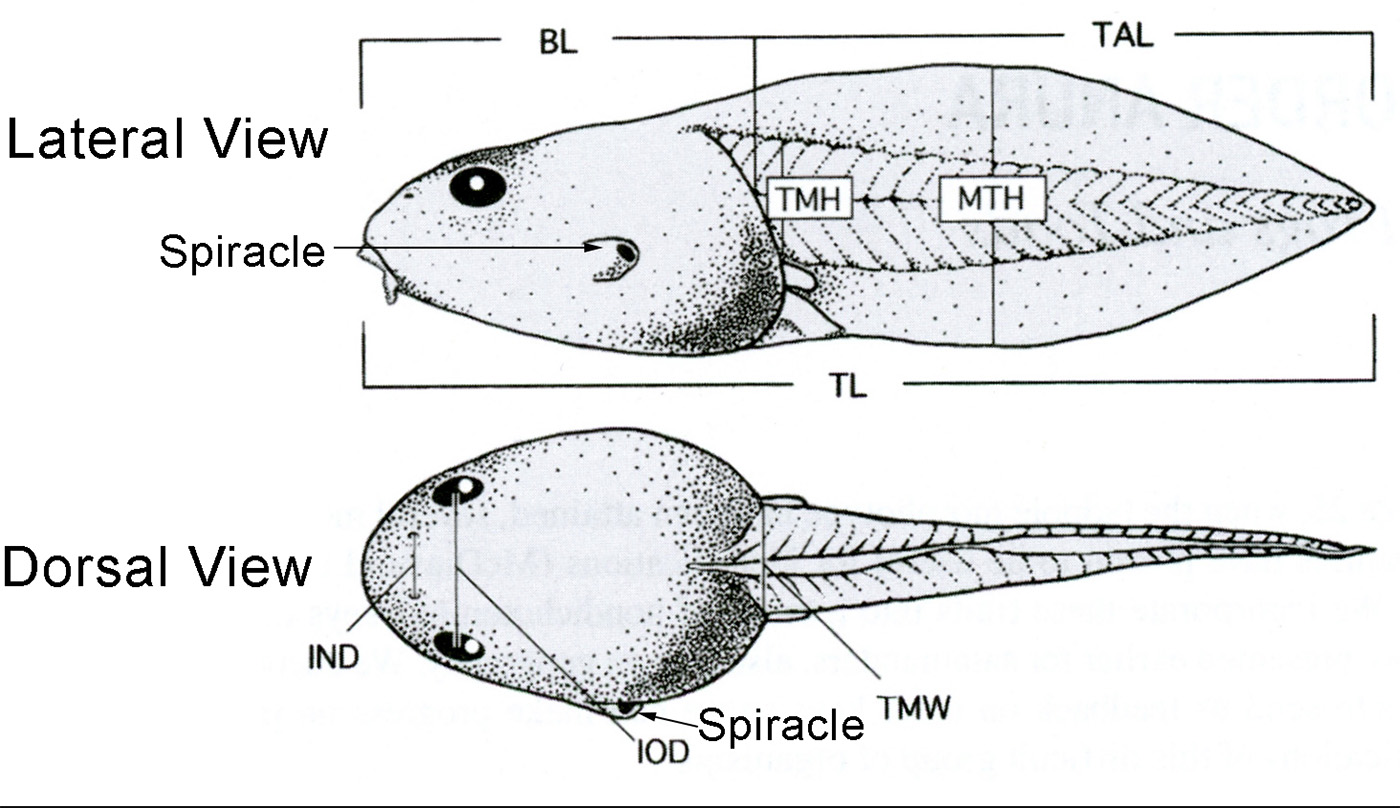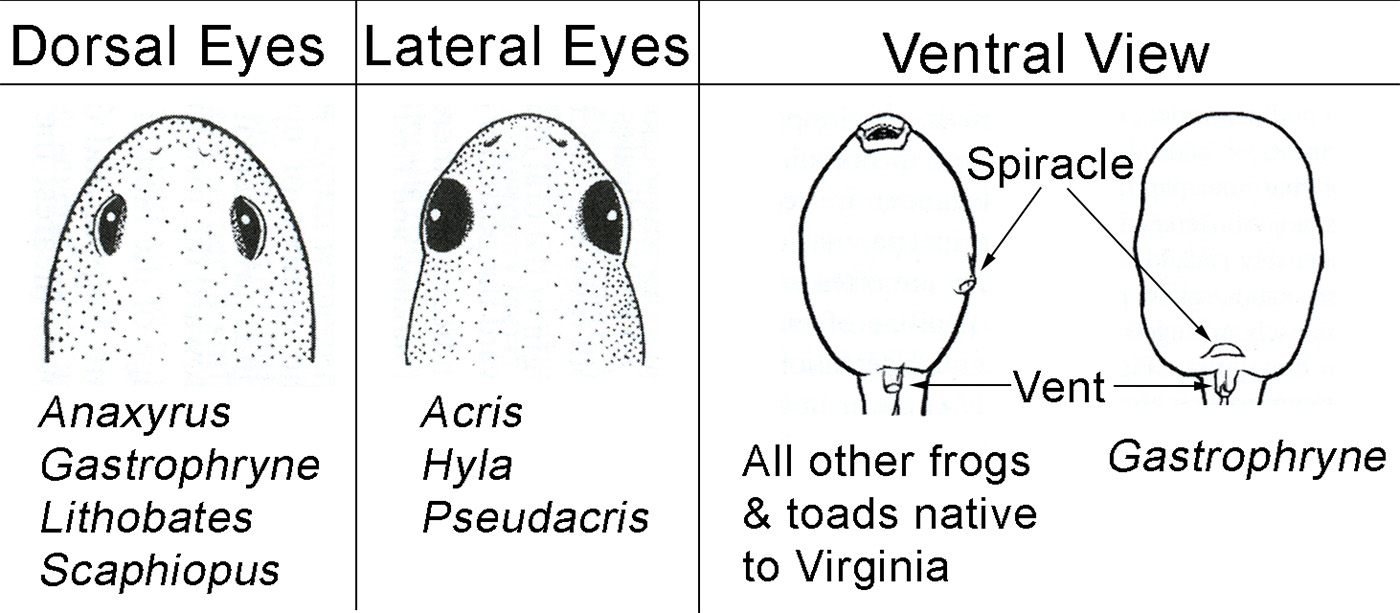Coastal Plains Leopard Frog
Lithobates sphenocephalus utricularius
Common Name: |
Coastal Plains Leopard Frog |
Scientific Name: |
Lithobates sphenocephalus utricularius |
Etymology: |
|
Genus: |
Lithobates is Greek, Litho means "A stone", bates means "One that walks or haunts". |
Species: |
sphenocephalus is Greek meaning "wedge headed". |
Subspecies: |
utricularius is Latin meaning "bagpipe" referring to the bagpipe-like vocal sacs. |
Average Length: |
2 - 3.5 in. (5.1 - 9 cm) |
Virginia Record Length: |
|
Record length: |
5 in. (12.7 cm) |
Physical Description - This species reaches lengths between 51 and 90 mm (2-3.5 in). The record length is 5 inches. The dorsal coloration is brown, green or some combination. There are a variable number of longitudinally elongated dorsal spots which may be entirely absent. The side of the body has only a few dark spots. There is a distinct light spot in the center of the tympanum and a light line along the upper jaw. The venter is white. Distinct dorso-lateral folds extend the full length of the body. Males are generally smaller, have paired vocal sacs, and enlarged forearms and thumbs. Male vocal sacs are spherical when inflated.
Reproduction - This species breeds in winter or early spring, occasionally in the fall. The male breeding call is described as a series of 3 to 5 guttural croaks followed by 2 or 3 "clucks" resembling the sound made by rubbing an inflated balloon. Males are difficult to approach when calling. The female attaches a cluster of several hundred eggs to vegetation submerged immediately beneath the water surface. The cluster is typically 90mm wide by 40mm thick. Breeding frogs frequently congregate and lay numerous clusters of eggs in a small area. Eggs will hatch in 1-2 weeks. Tadpoles are generally 20-25mm long. Metamorphosis occurs in about 3 months when the tadpole reaches 65-70 mm. The newly transformed frogs typically are 20 mm in length *1014*. Some research in Texas has found that this species calls year-round, breeds all months except September, and can be found in the larval stage from November through August. This species was found to produce 3 clutches in one study in Texas.
Altig & McDiarmid 2015 - Classification and Description:
- Eastern Clump
- Arrangement 2 - Eggs oviposited as large clump, surface lobate even in old, melded clumps, structure is maintained until hatching.
- Sub-arrangement B - Eggs deposited in non-flowing water, often ephemeral; Ovum Diameter 1.0-2.0 mm; Egg Diameter 2.5-5.6 mm; clump diameter 75-150 mm; clutch 3000-6000 or greater.
- Arrangement 2 - Eggs oviposited as large clump, surface lobate even in old, melded clumps, structure is maintained until hatching.
Tadpoles:

| Lateral View | Dorsal View |
|---|---|
| BL = Body Length | IND = Internarial Distance |
| MTH = Maximum Tail Height | IOD = Interorbital Distance |
| TAL = Tail Length | TMW = Tail Muscle Width |
| TL = Total Length | |
| TMH = Tail Muscle Height |

Behavior - This species is found in all types of freshwater habitats and even enters slightly brackish coastal marshes. They forage mostly on land. Insects are their primary prey item though they also feed on other arthropods and worms. This species will travel away from water when vegetation is available to provide shelter and shade. Breeding frogs typically congregate in large groups. Calling males are wary and difficult to approach. During development, larger tadpoles outcompete smaller individuals for food. However, as food levels decrease, chemical inhibition overrides exploitative competition.
Origin - This species is native.
Limiting Factors - This species needs grassy, marsh habitat to breed.
Aquatic/Terrestrial Associations - This species is found in all types of freshwater habitats but more frequently is associated with ponds, ditches, swamps, and lake and stream margins. Individuals are sometimes found in coastal brackish marshes. This species may venture away from water when weeds and other vegetation are available to provide shelter and shade.
References for Life History
- Conant, Roger and, Collins, John T., 1998, Peterson Field Guide: Reptiles and Amphibians, Eastern/Central North America, 616 pgs., Houghton Mifflin Company;, Boston
- Duellman, William E. and, Trueb, Linda, 1986, Biology of Amphibians, 671 pgs., The Johns Hopkins University Press, Baltimore
- Martof, B.S., Palmer, W.M., Bailey, J.R., Harrison, III J.R., 1980, Amphibians and Reptiles of the Carolinas and Virginia, 264 pgs., UNC Press, Chapel Hill, NC
- Wilson, L.A., 1995, Land manager's guide to the amphibians and reptiles of the South, 360 pp. pgs., The Nature Conservancy, Southeastern Region, Chapel Hill, NC
Photos:
*Click on a thumbnail for a larger version.
Verified County/City Occurrence
Accomack
Amelia
Amherst
Bedford
Botetourt
Brunswick
Campbell
Caroline
Charles City
Charlotte
Chesterfield
Dinwiddie
Essex
Fairfax
Fluvanna
Gloucester
Greensville
Halifax
Hanover
Henrico
Isle of Wight
James City
King and Queen
King George
King William
Lancaster
Loudoun
Louisa
Mathews
Mecklenburg
Middlesex
New Kent
Northampton
Nottoway
Orange
Pittsylvania
Powhatan
Prince Edward
Prince George
Prince William
Richmond
Smyth
Southampton
Stafford
Surry
Sussex
Warren
Westmoreland
York
CITIES
Chesapeake
Fairfax
Hampton
Newport News
Norfolk
Petersburg
Poquoson
Portsmouth
Suffolk
Virginia Beach
Williamsburg
Verified in 49 counties and 11 cities.













